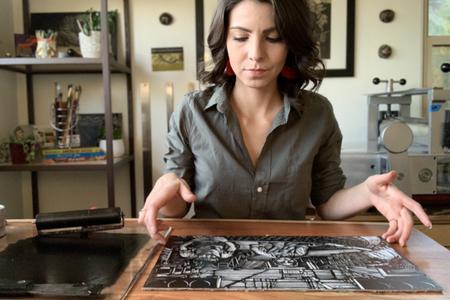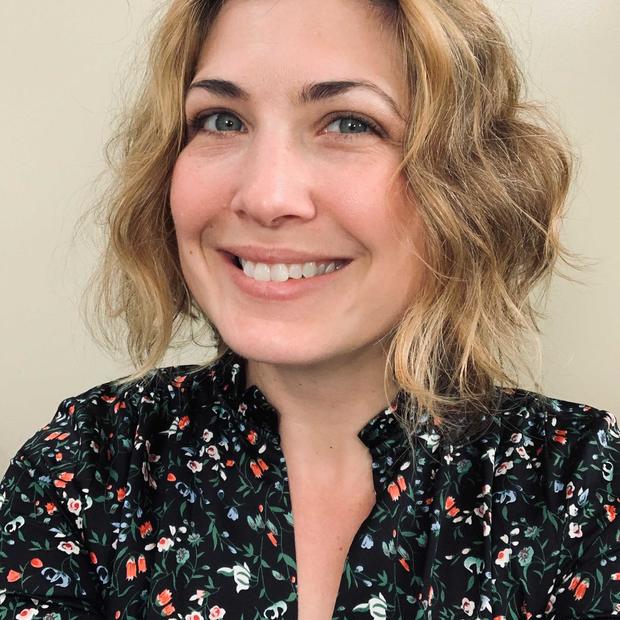Printmaking sparked her creativity like lightning. Drawing on nature scenes and her Mexican heritage, Tirado’s detailed and vibrant work conveys appreciation of and gratitude for the world around her, as well as a connection to this medium’s rich political history.
In Yakima she found further inspiration in the work of the area’s migrant and essential workers, creating vivid collections that capture the essence of their experiences and shed light on their stories.
This video is part of our “Made There” series about local artisans. View more videos from Seasons 1 and 2.
Tirado’s artwork has led to commissions and collaborations that celebrate hardworking people in agriculture, health care, and education. Her work can be seen throughout Washington, with installations in the new Medical Science Building at Washington State University in Spokane, the Tieton Arts and Humanities Mosaic Studio and the Farmworkers Clinic in Yakima and with displays at several schools through the Washington Arts Commission.
But her influence extends beyond Washington state borders, as her work is recognized across the country and internationally.
To ensure these essential workers feel seen and appreciated, Tirado spends time in the field with her subjects, getting to know them and building trust before taking photos to inform her prints.
Tirado’s artistic journey began in childhood. Born in Los Angeles, her family moved around before settling in Tacoma. Through the stops and starts of new homes, schools and friends, a constant in her life was art. One of her first big art memories is of creating an impressionist sunset for a third grade school art contest.
Tirado credits her mother with fostering her artistic interests:“My mother always bought me things to craft with, whether it was origami or creating beaded bracelets or jewelry or just pencils so I could sketch. It’s something that my mother has always nurtured in me.”
At first Tirado considered herself a painter, but while studying ceramics in college, a friend suggested a print class. The printmaking studio at the University of Washington opened a door that would change the trajectory of her art career. The versatility of block relief printing and the blend of creativity and strategy it required made it irresistible.
“It’s very meticulous and that’s one thing that I really appreciate. It keeps me thinking all the time about the next step, or three steps from now. So I’m not just working in that moment in time, I’m thinking about the various steps that are coming ahead. I like how I have to be very analytical. I have to synthesize everything that’s going on,” she explains. “So it’s very much working backwards. You have to know your end result to be able to start it.”
Each print needs a game plan. After she draws an image on tracing paper, she transfers it to the block, often made from linoleum or woodblock. She refines the image on the block with a pencil or fine point marker. From there she uses wood carving tools, or gouges, to carve the positive and negative spaces on the block.
When she’s satisfied with the carving, she loads ink onto a hand-held tool called a brayer by rolling it over a piece of glass until the tool’s cylinder is coated evenly. With the brayer, Tirado spreads the ink across the block’s raised image.
To create the print, she aligns paper over the inked block, then presses down or rubs on the paper with a weight or a wooden spoon, or she can run the block and paper through her printing press, until the image is transferred. For additional colors and detail, Tirado often adds them by hand directly to the print with inks, watercolors or other paints once the ink has dried completely.
Printmaking is more than the artistic conduit Tirado uses to express herself; she feels a strong bond to the process and its history. This traditional form of mass communication has roots in social political activism and protest, particularly in Mexico.
The notion of using printmaking to underscore the experiences of today’s migrant workers and those who have been historically underserved and marginalized felt like a natural direction for her.
“I began creating these pieces that reflect my heritage, but also continuing to work on culture, identity, including the people around me as well. So I began to create pieces that reflect the many realities of people that live here in Yakima, in particular a lot of our farmworkers in this community.”
As the daughter of Mexican immigrants, Tirado was a firsthand witness to her family’s experiences of working multiple jobs, feeling dismissed and isolated, and being excluded from the cultural and social tapestry of their environment. She wanted to use her personal experience to connect to people with backgrounds that resemble her own and put a face to those who provide the foundation for the area’s success in agricultural and essential services.
“I realized that the work that I was doing was impacting people outside of just here in my world, it was greater. I began to create pieces that also encompassed the community that I’m a part of now and started to be more intentional with who I’m portraying, who I’m creating, the lives of these people that historically haven’t been illustrated or represented. I wanted them to feel seen, and I wanted them to also feel a part of everything that’s happening here in Yakima. And I wanted them to feel important.”
Tirado’s work as a K-8 art teacher in Union Gap, Wash., has further informed her belief in creating lessons and programs that reflect the day-to-day realities of her students. And beyond that, she wants to ensure that art education is as accessible as possible.
“I feel like art education is really important. Being able to create, but also being able to read a work of art or just have permission to feel a work of art as well, that should be accessible to anybody. Art is a reflection of our heritage, can be a reflection of our cultures, of our ideas, of our thoughts, of our emotions,” Tirado said.
“Even if we maybe don’t want to feel inclined to create a work of art, I feel that just allowing yourself permission to connect with something and explore that, it’s just something that should be accessible to anybody.”
Get the latest in local arts and culture
This weekly newsletter brings arts news and cultural events straight to your inbox.



